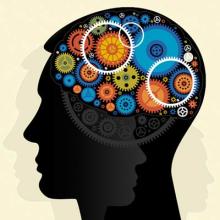Get a theory
By Amy Adams
Science has revealed a lot about how the brain's individual pieces hook together. But how do those signals whizzing to and fro throughout the brain add up to a love of tomatoes or memories of grandma? No clue.
"Let's say we could measure every neuron in the brain, and we could know the connectivity between every single pair of neurons," said Surya Ganguli, assistant professor of applied physics. "Now what? Does that data constitute an understanding of how the brain works?"
Ganguli says no. His field, called theoretical neuroscience, attempts to develop testable mathematical predictions for brain function.
As an example of where theory and experimental neuroscience intersect, Ganguli points to the work of Krisha Shenoy, professor of electrical engineering, who has recorded hundreds of neurons as monkeys perform simple arm tasks. The lab is applying what they learn from those recordings to develop a prosthetic arm that paralyzed people can control through brain activity.
A push in Shenoy's work and other areas of neuroscience had been to record ever larger numbers of neurons with the idea that more neurons would generate more information and better prostheses, but theory points a different direction.
"What we found from analyzing those data sets is that you may not need to record that many more neurons, but you may need to do many more trials with more complex behaviors," Ganguli said.
This finding not only guides the way his experimental colleagues set up experiments, it could also guide technology. Recording an ever-growing number of neurons would require scaling up existing recording technologies. But recording more complex tasks requires developing more stable technology for recording neurons that remains in place while an animal is moving, and over longer periods of time.
Ganguli said getting better information about how the brain controls the arm is only half the battle of developing a prosthetic limb or reverse-engineering a more human-like robot of the future. The brain uses feedback from the limbs like touch or stretch to fine-tune the signals it sends. Did the arm move too far or bump into an object? Ganguli is developing algorithms that explain how the brain takes in that information and modifies outbound signals in response.
Ganguli, who is also a member of Stanford Bio-X, said a final understanding of the brain will likely be made up of many interacting subsystems, like algorithms that explain limb movement or how the brain creates a map of the world. The sum of those mathematically defined subsystems will add up to an understanding of the brain itself – and the ability to reverse-engineer human-like capabilities.
